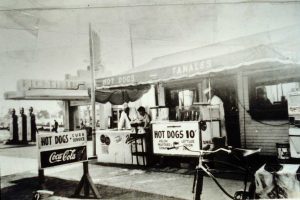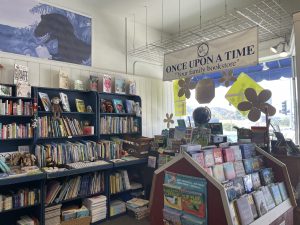Local journalist Mimi Slawoff’s new book, “Oldest Los Angeles” (Reedy Press), features more than 80 vignettes about L.A.’s oldest buildings, restaurants, neighborhoods, businesses, attractions and other places. Learn about local history and fun facts as you visit these diverse places throughout L.A. County. They make great day trips for families and you may even discover places you didn’t know existed.
Introduction
Los Angeles—which means The Angels in Spanish—is a sprawling city in Southern California that means different things to different people. For me, Los Angeles, nicknamed City of Angels and more commonly called L.A., is about the people—then and now. From its birth in 1781, when an ethnically diverse group of 44 settlers arrived in what is now downtown, Los Angeles has evolved into 88 incorporated cities, home to over 10 million people from around the world.
Located within the 4,084-square-mile Los Angeles County, these cities reflect the ethnic diversity of Los Angeles. Immigrants like my Bulgarian parents and their friends settled in neighborhoods, forming their own communities, starting businesses and sharing their traditions while assimilating to their new surroundings.
Oldest Los Angeles explores these cities and neighborhoods, some big, some small, and shares stories from the people who helped shape L.A., creating a delightful melting pot. As families established restaurants, bakeries, markets, flower shops, theaters, and a multitude of other businesses, L.A. developed into a diverse city with many layers that reveal the faces and cultures of L.A., from the past to the present. As a first-generation Bulgarian American and native Angeleno,I enjoy digging into L.A.’s past and exploring L.A. County with my three kids and visiting family and friends. There’s always something to please everyone, and I share some of these in Oldest Los Angeles.
Beaches? L.A. has 75 miles of sand and surf from Long Beach to Malibu, with historic lighthouses, piers, parks, and hidden canals. L.A. also has an abundance of outdoor spaces, with decades-old botanical gardens and even a 250-year-old grapevine still producing grapes.
The arts and culture scene boasts world-class theaters and museums and the world’s largest active excavation site where fossils from the Ice Age are still being discovered. And, of course, L.A. is known for glitz, glamour, and grit, but authentic Old Hollywood is best experienced in old-timey restaurants, venues, bars, and historic homes.
Oldest Los Angeles also visits the site of California’s first gold discovery in Newhall, a northern L.A. County town where there’s also a hidden ghost town and a park that’s home to roaming bison. What’s amazing is that despite the factI’ve lived in L.A. my entire life, I’m still discovering places like the oldest bowling alley, oldest dive bar, and a pharmacy with an old-fashioned soda fountain. So, while Oldest Los Angeles takes a journey to L.A.’s past and features over 84 oldest places, there are hundreds more to discover.
(Sidebar)Across the street, Los Angeles Union Station is a major transit hub that added to the pueblo area’s reinvigoration. Built in a Mission Moderne style in 1939, the station features art deco chandeliers, inlaid marble floors, hand-painted mission tiles, shaded patios, palm trees, and a clock tower. 800 N Alameda St
El Pueblo de Los Angeles Historical Monument
125 Paseo Pueblo de La Plaza
Situated in Downtown L.A., El Pueblo de Los Angeles Historical Monument marks the birthplace of the city. While the Gabrieleno-TongvaIndian Tribe first inhabited the L.A. basin, it was in September 1781 that 44 settlers of Native American, African, and European heritage established a farming community. As new settlers arrived, the humble pueblo evolved into a thriving community and L.A.’s incorporation as a city in 1850.
This oldest section of the city—a designated state historic park and a department of the City of Los Angeles since 1953—reflects the heritage of the many ethnic groups (Native American, Spanish, Mexican, Anglo, African American, Chinese, Italian, and French) that contributed to L.A.’s early history.
El Pueblo traces the steps and stories of these early settlers. The district consists of 27 historic buildings: 11 are restored and open as businesses and free museums—Plaza Firehouse, Chinese American Museum, the América TropicalInterpretive Center, the Sepulveda House Museum, the Italian American museum of Los Angeles, Avila Adobe, and the Museum of Social Justice. La Plaza de Cultura y Artes showcases performances and exhibits about Mexican and Mexican American history.
The hub is the 1820s Plaza and Olvera Street Marketplace (opened in 1930). Both host popular events and festivals. The best way to explore El Pueblo is on free, guided or self-guided walking tours. Put on your walking shoes and step back into19th-and 20th-century Los Angeles.
A good place to start is at the Plaza Firehouse, built in 1884 to house firefighting crews and their equipment. The neighboring Pico House, constructed between1869-1870, was L.A.’s first three-story building and luxury hotel. Built by PíoPico, the last governor of California under Mexican rule, the hotel had 80 bedrooms, 21 parlors, and bathrooms/water closets on each floor.
Debuting in1870 was the Merced Theatre, the first building dedicated to the theatre arts. The 1890 Garnier Building is the last surviving structure from the city’s original Chinatown and now houses the Chinese American Museum.
Nearby, La Iglesia de Nuestra Señora la Reina de Los Ángeles (Our Lady Queen of Angels Catholic Church) is an active parish built between 1818 and 1822.
Across the street, the América Tropical Interpretive Center showcases a once-controversial mural. The center is located inside the 1887 Sepulveda House, which represents the architectural and social transformation of Los Angeles from its early Mexican traditions to a blending of Mexican and Anglo culture.
Next door, there’s a preserved Italian Hall—which was built as a gathering place for the Italian community in 1908—inside the Italian American Museum of Los Angeles.
The Pelanconi House was built between 1855-57 by Italian vintner GiuseppiCovaccichi and converted to the Casa La Golondrina restaurant in 1924. A tour highlight is the well-preserved 1818 Avila Adobe, situated on Olvera Street—a great place for an authentic Mexican meal!
(Sidebar)Across the street, Los Angeles Union Station is a major transit hub that added to the pueblo area’s reinvigoration. Built in a Mission Moderne style in 1939, the station features art deco chandeliers, inlaid marble floors, hand-painted mission tiles, shaded patios, palm trees, and a clock tower. 800 N Alameda St.
Oldest Gold Discovery Site Placerita Canyon State Park
19152 Placerita Canyon Road, Newhall
Placerita Canyon is known for wildlife and hiking trails, but it’s also the site of the first gold discovery in California. The discovery of gold in Sutter’s Mill in Northern California, which often gets the credit for the discovery of gold, actually happened six years after gold was discovered in Santa Clarita Valley.
In 1842, rancher Francisco Lopez was herding cattle and hunting game with two men on his niece’s ranch in what is now called Placerita Canyon in the Santa Clarita Valley, 35 miles north of today’s Downtown L.A. They stopped for lunch, where Lopez fell asleep under the shade of an oak tree and dreamed he was floating in a pool of liquid gold.
After waking up, Lopez used his sheath knife to dig up some wild onions and saw little nuggets of gold clinging to the roots. Lopez’s discovery sparked California’s first gold rush.
Hundreds of prospectors flock to Santa Clarita to try their luck. An average of about 260 pounds of the metal annually was mined from the valley during the boom years, between 1842 and 1847.
The tree where Lopez reportedly had his golden nap is still there and is called The Oak of the Golden Dream.” The old, gnarled coast live oak is near Placerita Canyon Nature Center. The short, paved Heritage Trail leads to the tree. Along the way, there’s a tunnel featuring murals that depict the history of the canyon, from natural habitat to California Indianhomestead to ranch. The last panel reads, “A Dream Come True: Gold!”
(Sidebar) Placerita Canyon Natural Area is a 350-acre wildlife sanctuary with a nature center, hiking trails, and a seasonal stream and waterfall. Another on-site landmark is the Walker Cabin, built by the area’s first homesteader, Frank Walker, around 1920 for his family. 19152 Placerita Canyon Rd., Newhall.
Oldest Children’s Bookstore Once Upon a Time Bookstore
2207 Honolulu Ave., Montrose
The Palacios family, owners of the Once Upon a Time Bookstore, has a happily-ever-after tale to tell. After all, if not for them, the store might not be here today. The Children’s bookstore was the family’s neighborhood bookstore, founded in 1966 by local mom and artist Jane Humphrey. It’s where Maureen Palacios’daughters Jessica and Amelia bought their favorite books.
So, when Jane Humphrey decided to retire and sell the store in April 2003, they were devastated. Especially when no one offered to buy it. Worried about the store’s fate, Jessica—nine years old at the time—wrote a letter to the Los Angeles Times, asking, “Where will I find my fifth Harry Potter book if there is no ‘Once Upon A Time’?”
Maureen, who had worked in human resources for 20 years, and her husband decided to buy the store. Friends and family expressed concern about buying a bookstore at a time when online book sales were crushing independent bookstores. But the Palacioses did their homework, learning retail and pursuing their dream. Following Jane Humphrey’s advice, they chatted with customers, kept notes about their literary interests, and got to know their customers. Each year, sales increased.
And over the years, despite challenges that included a rent increase facilitating a move across the street, Maureen’s medical issues, and the COVID-19 pandemic, Once Upon a Time survived.
In the meantime, Jessica, now grown, became the buyer and store manager. The staff is composed of local youth who grew up visiting the store. Maureen Palacios credits the success to the store’s window displays, promotions of local authors, author signings, in-store events, a steady fan base, and the store’s high-profile location on a walkable street. The store is organized by age and themes, with books facing out to get noticed. “We want to please and excite the eye,” said Maureen Palacios. “We tend to have a story. We sell dreams. You have to get people to see the story and want that book.”
The bookstore, which has won many awards and accolades, is known for creating a good selection of diverse books for children and adults.
(Sidebar)At the front of the store is a child-sized red barn, inherited from Jane Humphrey, that holds stacks of books and doubles as a play area. And on hand to greet customers is Pippi, the family’s cat.
Author Mimi Slawoff is a Los Angeles native and a mom of three grown kids. Follow her on Twitter @Mimitravelz and Instagram @Mimitravels. MimiSlawoff.com.

































